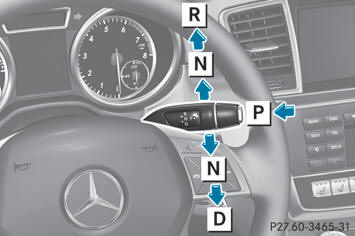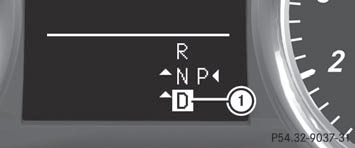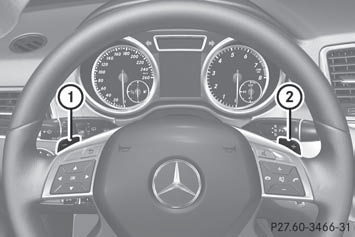Automatic transmission
Important safety notes
 WARNING
WARNING
It is dangerous to shift the automatic
transmission out of parking position P or
neutral position N if the engine speed is
higher than idle speed. If your foot is not firmly
on the brake pedal, the vehicle could
accelerate quickly forward or in reverse. You
could lose control of the vehicle and hit
someone or something. Only shift into gear
when the engine is idling normally and when
your right foot is firmly on the brake pedal.
 WARNING
WARNING
Keep in mind that turning off the engine alone
only will shift the automatic transmission into
neutral position N automatically.
Always shift the automatic transmission into park position P before turning off the engine.
Otherwise the vehicle could roll away which could result in an accident and/or serious personal injury.
DIRECT SELECT lever
Overview of transmission positions
The DIRECT SELECT lever is on the right of the steering column.

P Park position with parking lock
R Reverse gear
N Neutral
D Drive

The DIRECT SELECT lever always returns
to its original position. The current
transmission position P, R, N or D appears
in the transmission position display
in the multifunction display.
Engaging park position P
- Push the DIRECT SELECT lever in the direction of arrow P.

The automatic transmission shifts
automatically into park position P if you
open the driver's door when the vehicle is
stationary or driving at very low speed, and
the transmission is in position D or R.

If the engine speed is too high or the
vehicle is moving, do not shift the
automatic transmission directly from D to
R, from R to D or directly to P. The
automatic transmission could otherwise be
damaged.
Engaging park position P automatically
Park position P is automatically engaged if: - you switch off the engine using the SmartKey and remove the SmartKey, or if you switch off the engine using the Start/Stop button and open one of the front doors.
- the HOLD function (Y page 179) or DISTRONIC PLUS (Y page 169) brakes your vehicle until it is stationary and at least one of the following conditions is fulfilled: - there is a system malfunction.
- there is a severe uphill or downhill slope.
The electric parking brake is then also applied.
Engaging reverse gear R

Only shift the automatic transmission to
R when the vehicle is stationary.
- When the vehicle is stationary, depress the brake pedal.
- Push the DIRECT SELECT lever up past the first point of resistance.
Shifting to neutral N
- When the vehicle is stationary, depress the brake pedal.
- Push the DIRECT SELECT lever up or down to the first point of resistance.
If the engine has been switched off, the automatic transmission automatically switches to N.
Remaining in neutral N
If the automatic transmission is to remain in neutral N, e.g. for washing the vehicle in car washes with a towing device, please observe the following instructions:
 WARNING
WARNING
When leaving the SmartKey in the starter
switch, do not leave children unattended in
the vehicle. It is possible for children to switch
on the ignition which could result in
unsupervised use of vehicle equipment.
Unsupervised use of vehicle equipment could result in an accident and/or serious personal injury.
Using the SmartKey:
- make sure that the ignition is switched on.
- when the vehicle is stationary, depress the brake pedal and keep it depressed.
- shift to neutral N.
- release the brake pedal.
- if applied, release the electric parking brake.
- switch off the ignition and leave the SmartKey in the ignition lock.
Using KEYLESS-GO:
- make sure that the ignition is switched on.
- when the vehicle is stationary, depress the brake pedal and keep it depressed.
- engage park position P.
- release the brake pedal.
- remove the Start/Stop button from the ignition lock.
- insert the SmartKey into the ignition lock.
- switch on the ignition.
- depress the brake pedal and keep it depressed.
- shift to neutral N.
- release the brake pedal.
- if applied, release the electric parking brake.
- switch off the ignition and leave the SmartKey in the ignition lock.
Shifting to transmission position D
- When the vehicle is stationary, depress the brake pedal.
- Push the DIRECT SELECT lever down past the first point of resistance.
Transmission position display
The current transmission position is shown in the multifunction display.

1 Transmission position
The arrows in the transmission position display show how and into which transmission positions you can change using the DIRECT SELECT lever.

If the transmission position display in the
multifunction display is not working, you
should pull away carefully to check whether
the desired transmission position is
engaged. Select transmission position D.
Do not restrict the shift range.
Transmission positions
 Park position
Park position
Do not shift the transmission into position P(Y page 155) unless the vehicle is stationary. The parking lock should not be used as a brake when parking. In addition to engaging the parking lock, you must always apply the electric parking brake to secure the vehicle.
If the vehicle electronics are malfunctioning, the transmission may be locked in position P. Have the vehicle electronics checked at a qualified specialist workshop, e.g. an authorized Mercedes-Benz Center, immediately.
The automatic transmission shifts
to P automatically if you:
- remove the SmartKey
- switch off the engine when in R
or D and open one of the front
doors
 Reverse gear
Reverse gear
Only shift the transmission to R when the vehicle is stationary.
 Neutral
Neutral
Do not shift the transmission to N while driving. Otherwise, the automatic transmission could be damaged.
No power is transmitted from the engine to the drive wheels.
Releasing the brakes will allow you to move the vehicle freely, e.g. to push it or tow it.
If ESPЃ is deactivated or faulty:
only shift the transmission to position N if the vehicle is in danger of skidding, e.g. on icy roads.
If you switch off the engine using the SmartKey or the Start/Stop button, the automatic transmission shifts to neutral N automatically.

Rolling in neutral N can damage
the drive train.
 Drive
Drive
The automatic transmission changes gear automatically. All forward gears are available.
Changing gear
The automatic transmission shifts to the individual gears automatically when it is in transmission position D. This automatic gearshifting behavior is determined by: - a possible limitation of the shift range - the position of the accelerator pedal - the road speed
Driving tips
Kickdown
Use kickdown for maximum acceleration.
- Vehicles for USA: fully depress the accelerator pedal.
The transmission shifts to a lower gear depending on the engine speed.
- Vehicles for Canada: depress the accelerator pedal beyond the pressure point.
The transmission shifts to a lower gear depending on the engine speed.
Rocking the vehicle free
Rocking the vehicle free by shifting back and forth between transmission positions D and R can help to free a vehicle that has become stuck in mud or snow. The engine management system of the vehicle limits shifting back and forth between transmission positions D and R to a maximum speed of 5 mph (9 km/h). To shift back and forth between transmission positions D and R, move the selector lever up and down beyond the pressure point.
Working on the vehicle
 WARNING
WARNING
When working on the vehicle, engage the
electronic parking brake and shift the
automatic transmission into park position P.
Otherwise the vehicle could roll away which could result in an accident and/or serious personal injury.
Trailer towing
- Drive in the middle of the engine speed range on uphill gradients.
- Depending on the uphill or downhill gradient, shift down into shift range 3 or 2, even if cruise control or DISTRONIC PLUS are switched on.
Steering wheel paddle shifters

You can restrict or derestrict the shift range by using the steering wheel paddle shifters 1 and 2.

You can only change gear with the
steering wheel paddle shifters when the
transmission is in position D.
Shift ranges
Introduction
In transmission position D, you can use the steering wheel paddle shifter to restrict or derestrict the shift range for the automatic transmission (Y page 147).
The shift range selected is shown in the multifunction display. The automatic transmission shifts only as far as the selected gear.
Driving situations
3
You can use the engine's braking effect.
2
To use the braking effect of the
engine on downhill gradients and
for driving:
- on steep mountain roads
- in mountainous terrain
- in arduous conditions
1
To use the braking effect of the engine on extremely steep downhill gradients and on long downhill stretches
Restricting the shift range
- Pull the left-hand steering wheel paddle shifter.
The automatic transmission shifts down one gear and restricts the shift range to the relevant gear.

If the engine exceeds the maximum
engine speed when shifting down, the
automatic transmission protects against
engine damage by not shifting down.

If the maximum engine speed for the shift
range is reached and you continue to
accelerate, the automatic transmission
shifts up, even if the shift range is
restricted. This prevents the engine from
overrevving.
Derestricting the shift range
- Pull the right-hand steering wheel paddle shifter.
The shift range is derestricted.
Clearing the shift range restriction
- Pull and hold the right-hand steering wheel paddle shifter until D is shown again in the multifunction display.
The automatic transmission shifts from the current shift range directly to D.
or
- Use the DIRECT SELECT lever to shift the
transmission to position D.
The automatic transmission shifts from the current shift range directly to D.
Selecting the ideal shift range
- Pull the left-hand steering wheel paddle shifter and hold it in position.
The automatic transmission shifts to the gear which allows optimum acceleration and deceleration. To do this, the automatic transmission shifts down one or more gears.
Problems with the transmission
| Problem | Possible causes/consequences and
 Solutions Solutions |
| The transmission has problems shifting gear. | The transmission is losing oil. - Have the transmission checked at a qualified specialist workshop, e.g. an authorized Mercedes-Benz Center, immediately. |
| The acceleration ability is deteriorating. The transmission no longer changes gear. |
The transmission is in emergency mode. It is only possible to shift into second gear and reverse gear. - Stop the vehicle. - Shift the transmission to position P. - Switch off the engine. - Wait at least 10 seconds before restarting the engine. - Shift the transmission to position D or R. If D is selected, the transmission shifts into second gear; if R is selected, the transmission shifts into reverse gear. - Have the transmission checked at a qualified specialist workshop, e.g. an authorized Mercedes-Benz Center, immediately. |
See also:
Where will I find...?
First-aid kit
Ц Open the tailgate.
Ц Remove first-aid kit 1 from the parcel net.
Check the expiration date on the first-aid
kit at least once a year. Replace the
contents if necessary, an ...
Switching the windshield wipers on/
off
Do not operate the windshield wipers
when the windshield is dry, as this could
damage the wiper blades. Moreover, dust
that has collected on the windshield can
scratch the glass if wiping takes pl ...
Engine number
1 Emission control information plate,
including the certification of both federal
and Californian emissions standards
2 Engine number (stamped into the
crankcase)
3 VIN (on the lower edge of th ...
